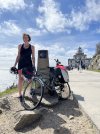Murk
New Member
- Time of past OR future Camino
- Via Podiensis & Frances, by bicycle, 2023
Hi all,
This Saturday my brother and I finished our Camino from Le Puy to Santiago by bicycle.
I had vaguely intended to make a live thread and post daily updates, but after the first day I immediately knew I wouldn’t have the energy (or will) to keep that up.
Someone told me bicigrinos are somewhat underrepresented on this forum, though.
So I figured I should write a reflection on our journey. Maybe it will be of use to someone?
The practical details
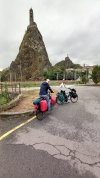
The bicycles
We rode classic road bikes with panniers, though slightly hybridized for gravel if necessary.
The weight of our luggage was about 18kg (for me) and 15kg (for my brother), the majority of which was camping gear (tents, sleeping bags, cooking kit, etc.) and food/drinks.
I needed four liters of water on sunny days, which is a lot of weight!
The bicycles performed fine on medium climbs, though on particularly steep climbs we ran into trouble. Both due to the gearing and the luggage weight.
We could handle elevation up to 10% fine, up to 12% for short climbs. Any elevation over 12% meant we had to walk.
But there were surprisingly few climbs that steep, and the number of times we had to walk was low. I can only think of a couple of occasions.
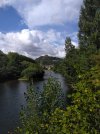
The route
We tried to follow the routes for both the Podiensis and the Frances as closely as possible.
For the Via Podiensis I relied heavily on the gpx files from this website. Slightly outdated on some stretches but overall great.
For most of the Podiensis, the roads run right next to the walking path (or sometimes above or below) - we would see the walking pilgrims next to us, up on the hills, or down in the valley. Which was great.
There are barely any car-free roads in France, but most of the route was low-traffic and the French drivers seem willing to give cyclists the space they need.
For the Frances I mixed some Komoot cycling routes, and the roads also stayed reasonably close to the walking path.
But not as well as in France, and we came to heavily rely on the Spanish N-roads. Sometimes we would lose sight of the walkers for several kilometers, which was a shame.
Those N-roads are of wildly varying cycleability. Whenever the new highway runs next to it, the N-roads are deserted and wonderful for cycling. Imagine having a four-lane road all to yourself, it's a dream come true.
But in the spots where the highway isn’t finished yet the N-roads are full of traffic, and the Spanish seem less inclined to give cyclists their space than the French.
For both the Podiensis and the Frances, we made ad-hoc decisions to cycle on the walking path wherever we deemed it possible.
That felt more like following the “actual” route (even though the historical path would often be where the car roads are now).
But “wherever we deemed it possible” wasn’t often.
The walking path is sometimes filled with rocks or even stairs - which our bicycles could handle but the luggage couldn’t.
But most importantly: on the walking paths, we quickly started feeling like a disruptive element. The walkers had to make way for us, and not all of them appreciated that. Whenever we shared the path with walkers we felt unwelcome (and maybe rightly so!)
So we only took the walking path whenever the surface allowed it and there were no walkers in sight. In all other cases we followed the roads.
Two exceptions: we followed parts of the walking path on the Meseta between Burgos and León (where the roads diverted too far from the route for my taste) and the last ten kilometers into Santiago (which we wanted to share with the walkers for the symbolism of it). For both of these, whenever the path got too busy we dismounted and walked.
I’ve seen it said on the forum that the signage on the Frances gives cycling alternatives wherever necessary. In my experience that is untrue, except for the last 200k.
On the rest of the Frances the signage for cyclists is very limited. There are some signs but few and far inbetween.
That’s not really a problem: paper maps or GPS navigation are easy enough. But you can’t go in blind and follow the signs the way you theoretically could do when walking.
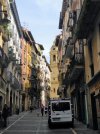
The length
The “official” length of the Camino from Le Puy via the Frances is about 1500 kilometers, an average of 75 kilometers a day.
In practice - including sight-seeing, getting to and from campings and supermarkets, detours - we cycled about 1650 kilometers, almost 85k a day.
We also climbed over 20,000 meters. We quickly came to realise that the elevation was far more important than the distance.
So we cut the trip into twenty stages of 1000 meter climbing, regardless of the distance traveled. Some days we traveled 40k, other days it was 100k, but we reached (or passed) the 1000 meter of climbing almost every day.
We are both relatively young, relatively fit, and used to cycling. But we come from the Netherlands where there is no elevation whatsoever, and we were completely inexperienced with cycling hills or mountains.
We knew that it was going to be a challenge, and it was!
Looking back, 85k and 1000 meters on average was just slightly too much. Only slightly: we made it work.
But most of our attention was on the physical challenge.
If we had scheduled 10k less every day it would have been perfect. That would have allowed us a bit more time to actually enjoy ourselves.
So would I advise a shorter route?
No, not really.
Starting in Saint-Jean would have been too short for us. Days of 45k average would not have been a challenge whatsoever. I know the Camino doesn’t need to be physically challenging, but I feel the physical challenge does contribute to the Camino feeling.
Starting halfway through the Via Podiensis sounds less-than-ideal too. The first half of the Le Puy route is the most interesting half by far.
So instead, I would advise to stick with the full Le Puy-Santiago route, but try to get a few more days. 25 days instead of 20 would have been perfect for us: physically challenging, but with enough time not to feel rushed.
Of course all of that depends on your experience and fitness level. If we had had prior experience with climbing hills we might have fared better.
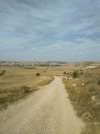
The daily life
As I mentioned, we slept on campings.
That was a deliberate choice. I know it is very different from what most pilgrims choose (either walking or cycling), so maybe this topic is not as relevant to others.
Either way, campings were plentifully available and easily accessible. For most of the Podiensis and Frances there would be campings close to the route (within 5k detour distance) at intervals of 20-30k.
Two exceptions: the long stretches of mostly flat farmland between Moissac-Beárn and Burgos-León. There, campings were sparse or completely unavailable. Especially between Moissac and Beárn we had to make longer days than we would have liked simply because there were no campings available.
On the plus side, even in late August/early September (the tail end of the peak season) we never had any issue getting a spot, and didn’t pre-book any camping for the whole twenty days.
Similarly, we relied mostly on supermarkets and grocery stores for food, rather than restaurants, bars and albergues (as most pilgrims might).
Supermarkets were also commonly available along the route, again with exception of the Moissac-Beárn and Burgos-León stretch.
A minor pet peeve: supermarkets in Spain open surprisingly late, which was troublesome for breakfast!
Due to our camping and supermarket habits, getting sellos for the Credencial was a bit tricky. All campings along the Frances had a stamp, but not all campings along the Podiensis did.
Moreover, we would try to schedule our lunch or midday break at a bigger city or church (where you would normally easily get a sello)... which of course overlaps with the siesta!
We were unable to get a sello at many prominent pilgrims’ places because we arrived during siesta time and everything was closed. That’s our own mistake - not blaming anyone else - but something to keep in mind.
For the last 200k to Santiago this was not an issue at all, since by then sellos were often do-it-yourself.
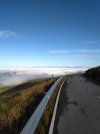
The Camino
It might be obvious to the experienced pilgrims on here, but:
A lot of the typical (and important) aspects of the Camino passed us by.
We would start cycling at 8:00, and we would often arrive at the camping at 17:00.
We did plenty of relaxation and sightseeing, but these were still long days and long distances.
So we would pass through a village around noon and we would see walking pilgrims finishing their days: they had arrived - while our day was only halfway done. Sometimes it was hard not to be jealous. It could feel like the walkers were able to experience the route in more depth.
Similarly, when you’re on a fast bicycle and you’re making long days, little towns lose their relevance. We would pass villages with ten houses and a church, and we would zip by it without a glance.
Which makes sense - but for walkers each of these villages is a prominent place, a place with meaning - rather than a place to pass and forget about immediately.
Again, most of this was a deliberate choice on our side.
But I think it’s important for would-be bicigrinos to keep in mind: a lot of what makes the Camino the Camino is dependent on going slow and being social.
If you want to go fast and be alone - like we wanted - that is fine but you will lose out on a huge part of the Camino.
If I am very honest, I would say our journey was more “Camino-themed” than a “Camino”.
We were spectators to the Camino, not participants. We saw the pilgrims, we saw the albergues, we visited the churches - we saw the Camino, but we weren’t really part of it.
Don’t get me wrong: our Camino-themed pilgrimage was great, and of great personal importance to me, and I am very happy I did it. I don’t feel less of a pilgrim for our way of traveling.
But if you want to deeply participate in the Camino, don’t do what we did. Use the albergues, find others cycling at your pace, maybe use a bicycle that can do the walking paths (so your stages will be shorter but still physically challenging).
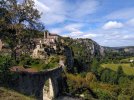
The highlights
We’ve had a wonderful journey.
It was exhausting and tough - a bit too tough at times - but beautiful nonetheless.
Some highlights (though there are far too many to list):
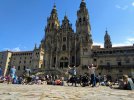
All in all
A definite recommendation from my end!
This Saturday my brother and I finished our Camino from Le Puy to Santiago by bicycle.
I had vaguely intended to make a live thread and post daily updates, but after the first day I immediately knew I wouldn’t have the energy (or will) to keep that up.
Someone told me bicigrinos are somewhat underrepresented on this forum, though.
So I figured I should write a reflection on our journey. Maybe it will be of use to someone?
The practical details
- Excluding travel to Le Puy and back home from Santiago, we had twenty cycling days.
- We followed the Via Podiensis from Le Puy to Saint-Jean-Pied-de-Port, and then the Camino Frances from Saint-Jean to Santiago.
- We stayed on campings along the route, and had our camping gear with us on the bicycles.
- We took the bicycles from the Netherlands to Le Puy by train; Correos is currently shipping them back home.

The bicycles
We rode classic road bikes with panniers, though slightly hybridized for gravel if necessary.
The weight of our luggage was about 18kg (for me) and 15kg (for my brother), the majority of which was camping gear (tents, sleeping bags, cooking kit, etc.) and food/drinks.
I needed four liters of water on sunny days, which is a lot of weight!
The bicycles performed fine on medium climbs, though on particularly steep climbs we ran into trouble. Both due to the gearing and the luggage weight.
We could handle elevation up to 10% fine, up to 12% for short climbs. Any elevation over 12% meant we had to walk.
But there were surprisingly few climbs that steep, and the number of times we had to walk was low. I can only think of a couple of occasions.

The route
We tried to follow the routes for both the Podiensis and the Frances as closely as possible.
For the Via Podiensis I relied heavily on the gpx files from this website. Slightly outdated on some stretches but overall great.
For most of the Podiensis, the roads run right next to the walking path (or sometimes above or below) - we would see the walking pilgrims next to us, up on the hills, or down in the valley. Which was great.
There are barely any car-free roads in France, but most of the route was low-traffic and the French drivers seem willing to give cyclists the space they need.
For the Frances I mixed some Komoot cycling routes, and the roads also stayed reasonably close to the walking path.
But not as well as in France, and we came to heavily rely on the Spanish N-roads. Sometimes we would lose sight of the walkers for several kilometers, which was a shame.
Those N-roads are of wildly varying cycleability. Whenever the new highway runs next to it, the N-roads are deserted and wonderful for cycling. Imagine having a four-lane road all to yourself, it's a dream come true.
But in the spots where the highway isn’t finished yet the N-roads are full of traffic, and the Spanish seem less inclined to give cyclists their space than the French.
For both the Podiensis and the Frances, we made ad-hoc decisions to cycle on the walking path wherever we deemed it possible.
That felt more like following the “actual” route (even though the historical path would often be where the car roads are now).
But “wherever we deemed it possible” wasn’t often.
The walking path is sometimes filled with rocks or even stairs - which our bicycles could handle but the luggage couldn’t.
But most importantly: on the walking paths, we quickly started feeling like a disruptive element. The walkers had to make way for us, and not all of them appreciated that. Whenever we shared the path with walkers we felt unwelcome (and maybe rightly so!)
So we only took the walking path whenever the surface allowed it and there were no walkers in sight. In all other cases we followed the roads.
Two exceptions: we followed parts of the walking path on the Meseta between Burgos and León (where the roads diverted too far from the route for my taste) and the last ten kilometers into Santiago (which we wanted to share with the walkers for the symbolism of it). For both of these, whenever the path got too busy we dismounted and walked.
I’ve seen it said on the forum that the signage on the Frances gives cycling alternatives wherever necessary. In my experience that is untrue, except for the last 200k.
On the rest of the Frances the signage for cyclists is very limited. There are some signs but few and far inbetween.
That’s not really a problem: paper maps or GPS navigation are easy enough. But you can’t go in blind and follow the signs the way you theoretically could do when walking.

The length
The “official” length of the Camino from Le Puy via the Frances is about 1500 kilometers, an average of 75 kilometers a day.
In practice - including sight-seeing, getting to and from campings and supermarkets, detours - we cycled about 1650 kilometers, almost 85k a day.
We also climbed over 20,000 meters. We quickly came to realise that the elevation was far more important than the distance.
So we cut the trip into twenty stages of 1000 meter climbing, regardless of the distance traveled. Some days we traveled 40k, other days it was 100k, but we reached (or passed) the 1000 meter of climbing almost every day.
We are both relatively young, relatively fit, and used to cycling. But we come from the Netherlands where there is no elevation whatsoever, and we were completely inexperienced with cycling hills or mountains.
We knew that it was going to be a challenge, and it was!
Looking back, 85k and 1000 meters on average was just slightly too much. Only slightly: we made it work.
But most of our attention was on the physical challenge.
If we had scheduled 10k less every day it would have been perfect. That would have allowed us a bit more time to actually enjoy ourselves.
So would I advise a shorter route?
No, not really.
Starting in Saint-Jean would have been too short for us. Days of 45k average would not have been a challenge whatsoever. I know the Camino doesn’t need to be physically challenging, but I feel the physical challenge does contribute to the Camino feeling.
Starting halfway through the Via Podiensis sounds less-than-ideal too. The first half of the Le Puy route is the most interesting half by far.
So instead, I would advise to stick with the full Le Puy-Santiago route, but try to get a few more days. 25 days instead of 20 would have been perfect for us: physically challenging, but with enough time not to feel rushed.
Of course all of that depends on your experience and fitness level. If we had had prior experience with climbing hills we might have fared better.

The daily life
As I mentioned, we slept on campings.
That was a deliberate choice. I know it is very different from what most pilgrims choose (either walking or cycling), so maybe this topic is not as relevant to others.
Either way, campings were plentifully available and easily accessible. For most of the Podiensis and Frances there would be campings close to the route (within 5k detour distance) at intervals of 20-30k.
Two exceptions: the long stretches of mostly flat farmland between Moissac-Beárn and Burgos-León. There, campings were sparse or completely unavailable. Especially between Moissac and Beárn we had to make longer days than we would have liked simply because there were no campings available.
On the plus side, even in late August/early September (the tail end of the peak season) we never had any issue getting a spot, and didn’t pre-book any camping for the whole twenty days.
Similarly, we relied mostly on supermarkets and grocery stores for food, rather than restaurants, bars and albergues (as most pilgrims might).
Supermarkets were also commonly available along the route, again with exception of the Moissac-Beárn and Burgos-León stretch.
A minor pet peeve: supermarkets in Spain open surprisingly late, which was troublesome for breakfast!
Due to our camping and supermarket habits, getting sellos for the Credencial was a bit tricky. All campings along the Frances had a stamp, but not all campings along the Podiensis did.
Moreover, we would try to schedule our lunch or midday break at a bigger city or church (where you would normally easily get a sello)... which of course overlaps with the siesta!
We were unable to get a sello at many prominent pilgrims’ places because we arrived during siesta time and everything was closed. That’s our own mistake - not blaming anyone else - but something to keep in mind.
For the last 200k to Santiago this was not an issue at all, since by then sellos were often do-it-yourself.

The Camino
It might be obvious to the experienced pilgrims on here, but:
- Staying on campings instead of albergues
- Not frequenting bars or restaurants
- Making long, fast days
- Using the roads instead of the walking path
A lot of the typical (and important) aspects of the Camino passed us by.
We would start cycling at 8:00, and we would often arrive at the camping at 17:00.
We did plenty of relaxation and sightseeing, but these were still long days and long distances.
So we would pass through a village around noon and we would see walking pilgrims finishing their days: they had arrived - while our day was only halfway done. Sometimes it was hard not to be jealous. It could feel like the walkers were able to experience the route in more depth.
Similarly, when you’re on a fast bicycle and you’re making long days, little towns lose their relevance. We would pass villages with ten houses and a church, and we would zip by it without a glance.
Which makes sense - but for walkers each of these villages is a prominent place, a place with meaning - rather than a place to pass and forget about immediately.
Again, most of this was a deliberate choice on our side.
But I think it’s important for would-be bicigrinos to keep in mind: a lot of what makes the Camino the Camino is dependent on going slow and being social.
If you want to go fast and be alone - like we wanted - that is fine but you will lose out on a huge part of the Camino.
If I am very honest, I would say our journey was more “Camino-themed” than a “Camino”.
We were spectators to the Camino, not participants. We saw the pilgrims, we saw the albergues, we visited the churches - we saw the Camino, but we weren’t really part of it.
Don’t get me wrong: our Camino-themed pilgrimage was great, and of great personal importance to me, and I am very happy I did it. I don’t feel less of a pilgrim for our way of traveling.
But if you want to deeply participate in the Camino, don’t do what we did. Use the albergues, find others cycling at your pace, maybe use a bicycle that can do the walking paths (so your stages will be shorter but still physically challenging).

The highlights
We’ve had a wonderful journey.
It was exhausting and tough - a bit too tough at times - but beautiful nonetheless.
Some highlights (though there are far too many to list):
- The very first climb out of Le Puy-en-Velay, which was probably the steepest, toughest climb of the whole Camino and made us think “We have made a huge mistake”... and the subsequent confidence and pride that came with succeeding.
- Conques, and especially the climb opposite of Conques, rising higher and higher while keeping sight on the town below us.
- The Lot valley: Espalion, Estaing, Saint-Cirq-Lapopie - and the Célé variant, especially with a visit to Pech Merle.
- Crossing the Pyrenees. The Valcarlos route is great for cyclists, a constant but mild climb for twenty kilometers and then - when you reach the top - the stunning view back into the valley.
- Going westward from Pamplona and seeing the towns getting smaller and smaller yet the cathedrals in those towns getting bigger and bigger.
- The dry desert of the Meseta, especially the view back from the Alto de Mostelares.
- The fast, twisting descent after the Cruz de Ferro, which were the most adrenaline-fueled kilometers of our whole Camino.
- Arriving in Santiago itself, obviously.

All in all
A definite recommendation from my end!
Last edited:








